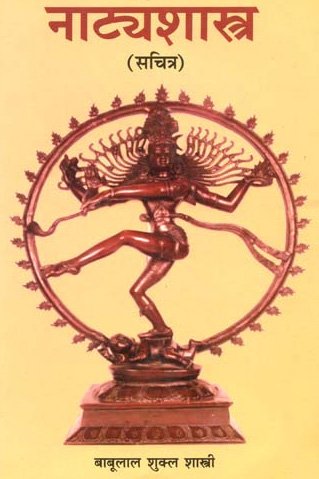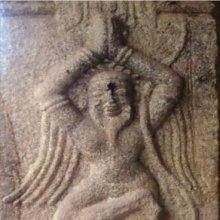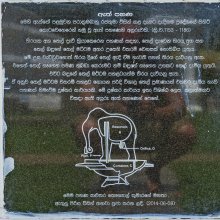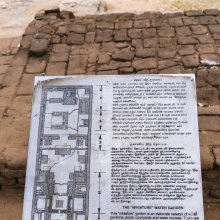Flowing, Flow, Flowed: 2 definitions
Introduction:
Flowing means something in Hinduism, Sanskrit. If you want to know the exact meaning, history, etymology or English translation of this term then check out the descriptions on this page. Add your comment or reference to a book if you want to contribute to this summary article.
Images (photo gallery)
(+2 more images available)
In Hinduism
Natyashastra (theatrics and dramaturgy)
Source: Shodhganga: Elements of Art and Architecture in the Trtiyakhanda of the Visnudharmottarapurana (natya)The Flowing of Tears refers to one of the various expressions (or emotions, feelings, etc.) in Sanskrit drama that are conveyed through Sātvikābhinaya, which represents one of the four divisions of Abhinaya or “ways to convey or represent one’s emotion to others” (in Sanskrit Drama), according to the Viṣṇudharmottarapurāṇa, an ancient Sanskrit text which (being encyclopedic in nature) deals with a variety of cultural topics such as arts, architecture, music, grammar and astronomy.—Sātvikābhinaya that deals with the feelings, emotions and expressions, conveyed by the actors. Flow of tears, horripilation, sweating, throbbing of heart and faultering speech come under the sātvikābhinaya. It is important to note here that in the Nāṭyaśāstra the word bhāvabyañjaka is used for the sātvikābhinaya. When the inner ideas of a dramatist are expressed by means of words, gestures, facial expressions and the representation of sattva, those are called bhāvas. [...]

Natyashastra (नाट्यशास्त्र, nāṭyaśāstra) refers to both the ancient Indian tradition (shastra) of performing arts, (natya—theatrics, drama, dance, music), as well as the name of a Sanskrit work dealing with these subjects. It also teaches the rules for composing Dramatic plays (nataka), construction and performance of Theater, and Poetic works (kavya).
Yoga (school of philosophy)
Source: ORA: Amanaska (king of all yogas): A Critical Edition and Annotated Translation by Jason Birch1) The Flow (of the breath) is denoted by the Sanskrit term Pravāha, according to the Amanaska Yoga treatise dealing with meditation, absorption, yogic powers and liberation.—Accordingly, as Īśvara says to Vāmadeva: “[...] [Now], I shall define the nature of that highest, mind-free absorption which arises for those devoted to constant practice. [...] By means of an absorption for one breath, the [principal five] bodily winds beginning with Prāṇa, flow to their own places because of the complete restraint of the flow (pravāha) of the breath. [...]”.
2) Flowing (along a particular path) can be defined by the Sanskrit term Vāhinī, according to the Amanaska Yoga.—Accordingly, as Īśvara says to Vāmadeva: “[...] [Now], I shall define the nature of that highest, mind-free absorption which arises for those devoted to constant practice. [...] By means of an absorption for a fourth of a Kalā (i.e., ninety breaths), [Kuṇḍalinī] who flows (vāhinī) along the path [called] Suṣumnā, goes partially through [this] path [which is] at the back of the [Yogin's] body. [...]”.

Yoga is originally considered a branch of Hindu philosophy (astika), but both ancient and modern Yoga combine the physical, mental and spiritual. Yoga teaches various physical techniques also known as āsanas (postures), used for various purposes (eg., meditation, contemplation, relaxation).
See also (Relevant definitions)
Full-text (+2967): Pravaha, Shrava, Vahin, Prasrava, Vishrava, Nirgalita, Vishruta, Syandin, Vishyanda, Drava, Prasarin, Dravana, Visravita, Pravah, Raktasrava, Samshrava, Nisyanda, Shruta, Dhavana, Bagai.
Relevant text
Search found 399 books and stories containing Flowing, Flow, Flowed; (plurals include: Flowings, Flows, Floweds). You can also click to the full overview containing English textual excerpts. Below are direct links for the most relevant articles:
Chaitanya Bhagavata (by Bhumipati Dāsa)
Verse 2.198 < [Chapter 2 - The Lord’s Manifestation at the House of Śrīvāsa and the Inauguration of Saṅkīrtana]
Verse 1.14.58 < [Chapter 14 - The Lord’s Travel to East Bengal and the Disappearance of Lakṣmīpriyā]
Verse 1.9.121 < [Chapter 9 - Nityānanda’s Childhood Pastimes and Travels to Holy Places]
Rivers in Ancient India (study) (by Archana Sarma)
7. The river Sindhu in the Purāṇas < [Chapter 5 - Rivers in the Purāṇic Literature]
1. The river Sarasvatī and its Present Status < [Chapter 6 - Changing trends of the Rivers from Vedic to Purāṇic Age]
4. Disappearance of Sarasvatī < [Chapter 6 - Changing trends of the Rivers from Vedic to Purāṇic Age]
The Markandeya Purana (by Frederick Eden Pargiter)
Canto LVI - The Descent of the Ganges
Canto LVII - The Geography of Bhārata
The Brahmanda Purana (by G.V. Tagare)
Chapter 18 - Description of the Jambūdvīpa < [Section 2 - Anuṣaṅga-pāda]
Chapter 13 - Enumeration of holy spots (tīrtha) for Śrāddha < [Section 3 - Upodghāta-pāda]
Chapter 19 - Description of Plakṣa and other continents (dvīpa) < [Section 2 - Anuṣaṅga-pāda]
Chapter XX - The Nature Of Rivers
Chapter XIII - The Nature Of The Oceans
Historical Elements in the Matsya Purana (by Chaitali Kadia)
The River Gaṅgā or Ganges < [Chapter 4 - Geographical history in the Matsya-Purāṇa]
The Kailāsa Mountain < [Chapter 4 - Geographical history in the Matsya-Purāṇa]
Saptadvīpa (4): Krauñcadvīpa < [Chapter 4 - Geographical history in the Matsya-Purāṇa]
Related products
(+8 more products available)











